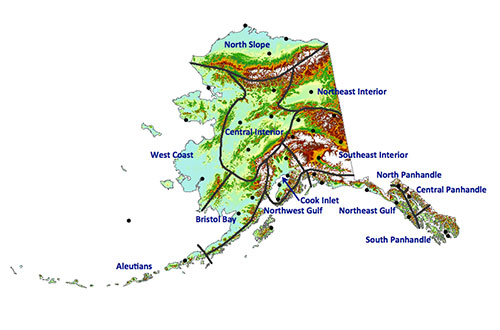
Research helps climate monitoring and predictions in AlaskaBy Yuri Bult-Ito
March 10, 2015
University of Alaska Fairbanks researchers and collaborators created the divisions, which describe zones that have broadly similar climate variations over time. Governmental agencies use such divisions to monitor climate and analyze temperature, precipitation and drought. The private sector also uses them for agricultural and hydrological applications. A team of scientists created 13 climate divisions for Alaska, regions that have broadly similar climate variations over time.
The climate divisions for Alaska, a project started by a team of scientists in 2010, will change that. Peter Bieniek, a postdoctoral fellow at the UAF International Arctic Research Center, calculated climate divisions for Alaska as part of his Ph.D. thesis in atmospheric sciences with his advisor, Uma Bhatt of the UAF Geophysical Institute. Rick Thoman, of the National Weather Service in Fairbanks, provided the forecasters’ perspective from the start. The scientists looked at weather stations in Alaska and applied statistical analysis to group them according to similar climate variability. This resulted in 13 climate divisions in the state. Later, they developed data for each zone, which allows the federal agencies such as the National Climatic Data Center and the Climate Prediction Center to use climate divisions to diagnose climate variations in Alaska. Once the science was finished, James Partain of the NCDC navigated the process needed to receive official recognition from NWS and NCDC’s parent agency, the National Oceanic and Atmospheric Administration. With collaboration between the many university scientists and NOAA meteorologists, the project was a successful example of transforming scientific research into a practical application. The NCDC is rolling out the official climate divisions for Alaska. The divisions will allow the CPC to produce more accurate climate outlooks for Alaska, which will help people better prepare for the upcoming summer. During the past five years, Bieniek has continued to refine climate division ideas. He hopes the divisions will generate more refinements that will improve climate monitoring and predictions in Alaska. “For me, what’s important about this project is that it will start the discussion,” he said. The collaboration resulted in a paper, “Climate Divisions for Alaska Based on Objective Methods,” published in the Journal of Applied Meteorology and Climatology.
Contact Yuri Bult-Ito at ybult-ito@iarc.uaf.edu
Source of News:
|
||
